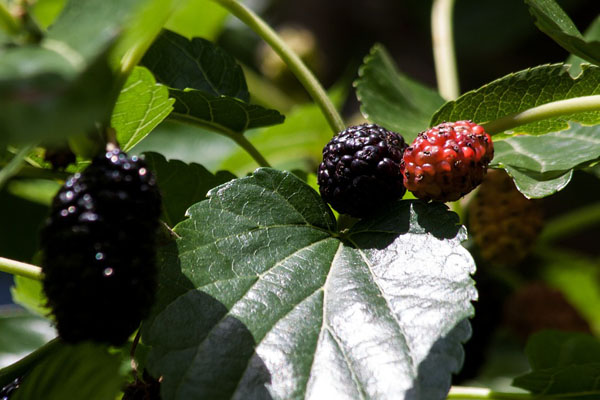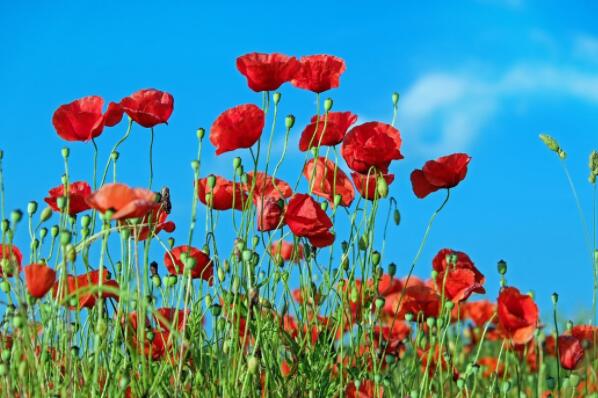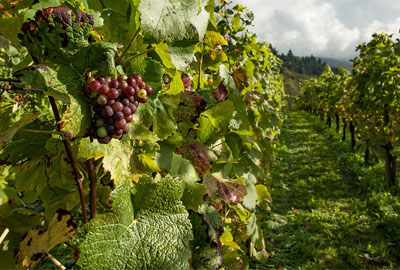How many times a year do mulberry trees bear fruit? How can we grow more fruit?
Fruit mulberry is a kind of common tree seedling in our country, its fruit is not only edible, but also can be used in industrial production, so the price is expensive, but because the shelf life of fruit mulberry is very short, if you want to eat mulberry, you need to know the period of mulberry fruit. how many times a year does the mulberry bear fruit? How can we grow more fruit?

According to the growth law of the plant, mulberry bears fruit and blossoms once a year, its flowering period is in April, and the fruit ripening is from May to July. Some in order to be able to eat mulberry, a series of mulberry management, so that mulberry bear fruit more than once a year, but the phenomenon is very few.
Planting method:
I. Variety selection
The full fruit period of fruit mulberry is more than 30 years, and excellent varieties can be selected according to the purpose of cultivation and climate. In China, excellent fruit mulberry varieties with large fruit shape, high yield and strong adaptability have been selected by the combination of biotechnology and traditional technology. The fresh food and processing varieties that can be selected in the north are seedless big ten, Hongguo 1, Hongguo 2, Hongguo 3, Hongguo 4, Baiyuwang and so on, and 8632 hybrid varieties are suitable for processing. In the south, we can choose fresh food and processing varieties such as 46CO19, Yue Rou Da 10, etc. The yield of mulberry per mu is generally 1500-2000 kg.
II. Selection and construction of garden sites
Fruit mulberry has strong adaptability, and it is suitable to choose sandy soil blocks with deep and fertile soil layer, rich organic matter, soil pH value of 6.5-7.5, gentle terrain, high groundwater level, convenient drainage and irrigation, far away from dust and other pollution sources to build a garden.
III. Land preparation and planting
1. The planting time is mainly before sprouting in early spring and in early winter after defoliation.
two。 The land should be leveled before land preparation and planting, after a full ploughing depth of about 25 cm, and a good drainage channel should be dug. The planting density is controlled in the range of 300 × 500 plants per mu, and the row spacing is 1.5 × 2 m × 1 m. According to the topography, the planting ditch with a depth of 50 cm and a width of 60 cm is generally dug in the north-south direction, and 5000 kg of rotten organic fertilizer, 150kg of ternary compound fertilizer and 100kg of cake fertilizer such as soybean meal are applied per mu, which are mixed with the topsoil and filled into the ditch.
3. When planting, extend the mulberry seedling root system around evenly, gently lift the seedling and shake when backfilling half of the soil, so that the root system is in full contact with the soil, step on the soil until the soil is level with the ground, and build a cofferdam to water once. After planting, the ridge is ridged forward, the ridge height is 15cm to 20cm.
IV. Management of young trees
Within two years after planting, it is mainly to cultivate tree shape and promote strong fruit branch management.
1. Fertilization was applied before sprouting and leaf canopy formation of young trees, respectively, 100 grams of urea or 5 grams of biogas liquid was applied to plants; in the middle of May, plants were applied 30 grams of potassium sulfate compound fertilizer; in July and after, 0.3% potassium dihydrogen phosphate solution was sprayed on the leaves for 3 times. Through many times of topdressing, we can comprehensively promote the accumulation of tree nutrition and promote the formation of fruit branches.
two。 Before sprouting of fruit mulberry in spring, the mulberry should be irrigated once with fertilization, after each topdressing and when the soil moisture is poor, it is best to cover the tree plate with grass (or crop straw) after irrigation (www.nczfj.com) to reduce water evaporation. The soil in the northern region is filled with frozen water before freezing to ensure that young trees survive the winter safely.
3. The plastic fruit mulberry is mainly shaped by the method of middle dry cultivation, and spring cutting should be used in the first two years. In the year of planting, shoot and cultivate the trunk at the height of 40-50 cm. After germination, 2-3 new buds with strong and suitable direction were selected on the stem, and the rest were thinned out to promote 2-3 new branches in the same year. Before sprouting in the following spring, the first branch was cut in spring at 65-80 cm from the ground. After germination, 2-3 new shoots were selected for each branch, and 4-6 branches were cultured per plant. Plastic management should integrate the techniques of branch release, retraction and branch thinning, and adjust the size of the crown in time to ensure ventilation and light transmission.
Fifth, result tree management
The third year of planting entered the normal fruiting period, paying attention to regulating the balance between vegetative growth and reproductive growth, overcoming the phenomenon of big and small years, and ensuring high and stable yield.
1. Before topdressing sprouted in early March, trench was opened 20 cm away from the tree trunk and 30 kg of ternary compound fertilizer was applied per mu. Before flowering and young fruit stage, potassium sulfate compound fertilizer was applied once respectively to promote pollination and young fruit expansion, usually 20-30 kg per mu. (www.nczfj.com) at the initial flowering stage and young fruit stage, 0.3% potassium dihydrogen phosphate was sprayed on the leaves for 3 times to increase the sugar content of the fruit, make the mulberry fruit bright and colorful, and promote stable yield and yield.
two。 The sprouting period of irrigation and drainage in spring is the peak of water demand, which should be irrigated timely according to soil moisture and after topdressing. Keep the ditches inside and outside the garden unblocked in the rainy season, stop the rain and dry without stagnant water, reduce the humidity in the field and reduce the spread of germs.
3. During the sprouting period in the middle and last ten days of March, the hidden buds germinated on the trunk, the dense buds and weak buds at the base of the fruiting mother branch were erased to concentrate nutrition and reduce nutrient consumption.
4. When picking leaves during the expansion period of mulberry, two or three pieces of dense mulberry leaves at the base of the fruiting mother branch and the middle and lower part of the branches should be removed properly to enhance ventilation and light transmission, help to accumulate nutrition, increase the sugar content of mulberry and improve the marketability of fruit.
VI. Mulberry harvesting
1. The sign of mulberry maturity is that the fruit stem changes from green to yellow and white, and the purplish red variety changes from red to purple.
two。 The harvest time of mulberry is better in the early morning when the temperature is lower. After the temperature decreased at night, the fruit temperature also decreased, and the shelf life could be prolonged by 3-5 days by picking at this time.
3. The mature period of mulberry harvesting method is inconsistent, which lasts about 1 month, and should be picked in batches, usually once every 5 days. Mulberry pulp is soft and not resistant to storage and transportation, it is best to pick by hand, put on aseptic gloves before harvest, and handle gently when picking, so as not to damage the epidermis. The fruits of higher places such as treetops and branches can not only be harvested by shaking with clean plastic sheeting on the ground, but also be picked by special fruit-picking ladders.
4. Packaging and sale are screened and graded according to the size of the fruit, first covered with plastic wrap, each box is 500 grams 800 grams, and then packed into a special fruit box; mulberry sales should establish their own brand, mulberry grade, brand name, fruit photo, packing weight, planting base name, contact address, contact number and so on should be printed on the outer surface of the fruit box, which should be shipped to the fruit market in time after packing.
VII. Postharvest management
1. Summer pruning is carried out after fruit harvest in June every year. on the basis of tree-shaped pruning of young trees, the branches are cut off from the base to regenerate new branches, and pruning should be carried out at noon on a sunny day to reduce bleeding. There are a large number of buds sprouting 10-15 days after pruning, so we should wipe the buds and fix the shoots in time, and keep 3-5 new shoots per branch as the fruiting mother branch in the coming year; at the same time, we should remove the overdense twigs and weak branches and concentrate on nutrition to grow good hanging fruit branches. After that, summer pruning was carried out at the base of the branches every year, and the secondary branches were cultured at 1 meter above the ground. after germination, 2-3 buds were selected for each branch, and 8-12 branches were cultured for each plant, which gradually formed dry mulberry and mulberry boxing, and increased the number of fruiting branches.
two。 Fertilizer and water management fertilization is mainly organic fertilizer, supplemented by compound fertilizer, using ditch application and hole application respectively. After fruit harvest, topdressing should be carried out in time to promote fruit branches to be hung in the following year. About 5 days after summer felling, 10: 15 kg of urea was applied per mu; in the first ten days of July, ternary compound fertilizer or urea was applied per mu of 20: 30 kg; in late August, base fertilizer was applied in autumn, 1000-1500 kg of rotten organic fertilizer and 20: 30 kg of ternary compound fertilizer were applied per mu to promote the Lignification of branches and prolong the high yield cycle of mulberry garden. Irrigation in time according to soil moisture in summer and autumn, and winter irrigation before freezing.
3. Leaf-picking mulberry can not only harvest mulberry, but also use mulberry leaves to raise silkworms. After harvest, leaves can be collected for sericulture in summer and autumn. Pay attention to the combination of picking and cultivation, leave the stalk when picking leaves so as not to hurt the mulberry buds, and keep 10 or 15 mulberry leaves on the branches to raise trees.
4. Intermediate tillage and weeding can inhibit soil water evaporation, store water and preserve soil moisture, and reduce the overwintering base of diseases and insect pests. One deep turning should be guaranteed, and two or three times of ploughing and weeding in summer and autumn should be guaranteed.
5. Winter shearing should be carried out in order to fully concentrate nutrients and improve the yield and quality of mulberry fruit. Winter shearing is carried out from late November to early January after defoliation, and it is easy to produce winter buds in autumn prematurely, affecting the yield of the following year. Focus on cutting off the tender shoots 10 to 20 cm long at the top of the branches, as well as disease and insect branches, over-dense branches and weak branches.
VIII. Disease and pest control
The main diseases of fruit mulberry are brown spot, anthracnose, powdery mildew, Sclerotinia sclerotiorum and so on, and the main pests are mulberry caterpillar, mulberry inchworm, diamond leafhopper, mulberry longicorn beetle and so on. In order to ensure the safety of fruit consumption, artificial and biological control should be given priority to, supplemented by chemical control of pesticides with high efficiency, low toxicity and low residue. Timely removal of withered branches and leaves in the garden in winter and concentrated burning; timely cutting off diseased and weak branches in late winter and early spring to ensure ventilation and light transmission, kill pathogens and reduce the chance of fruit infection. One week before sprouting, the trees and the ground were thoroughly disinfected with 3-5 Baumetulite-sulfur mixture. From the budding period to half a month before fruit harvest, the trees were sprayed alternately with 50% carbendazim wettable powder 600 times, 75% chlorothalonil or 70% methyl thiophanate 800 times to prevent the occurrence of diseases, once or twice a month. For mulberry longicorn beetles, during the adult occurrence period from July to August, the phototaxis of adults was used to hang black light to trap and kill other pests. 4000-fold solution of imidacloprid could be used to control other insect pests.
Time: 2019-04-10 Click:
- Prev

When does the herb Yu Mei usually sow and blossom? How long is the growth cycle? How do you plant it?
Yu Mei, also known as Lichun, Sai Peony, Manyuan Spring, Artemisia annua, Yumei Grass, Dance Grass, is commonly cultivated in various parts of China. So when does it usually sow and blossom? How long is the growth cycle? How do you plant it? According to the data of Papaveraceae, Yumei is a biennial herb.
- Next

How many times a year does the "god of fruit" vine blossom? How many times do you bear fruit? How can it blossom and bear fruit?
Grape is a kind of fruit tree widely planted in China, which is favored by the majority of growers because of its sweet taste, rich nutrition and simple planting skills, but because there are many varieties of grapes and different planting skills, if you want to plant grapes well, you need to master the characteristics of grapes.
Related
- Fuxing push coffee new agricultural production and marketing class: lack of small-scale processing plants
- Jujube rice field leisure farm deep ploughing Yilan for five years to create a space for organic food and play
- Nongyu Farm-A trial of organic papaya for brave women with advanced technology
- Four points for attention in the prevention and control of diseases and insect pests of edible fungi
- How to add nutrient solution to Edible Fungi
- Is there any good way to control edible fungus mites?
- Open Inoculation Technology of Edible Fungi
- Is there any clever way to use fertilizer for edible fungus in winter?
- What agents are used to kill the pathogens of edible fungi in the mushroom shed?
- Rapid drying of Edible Fungi

